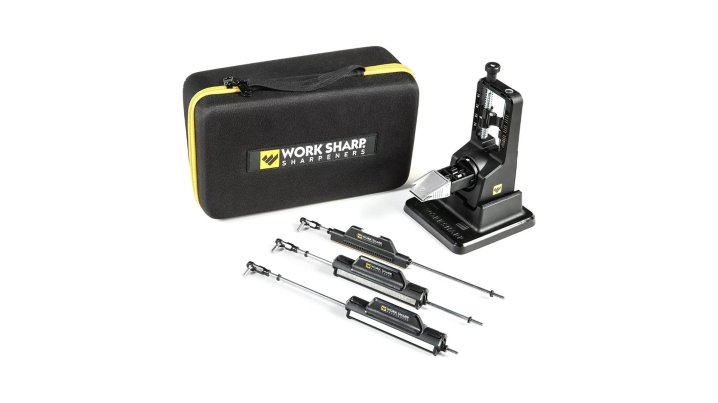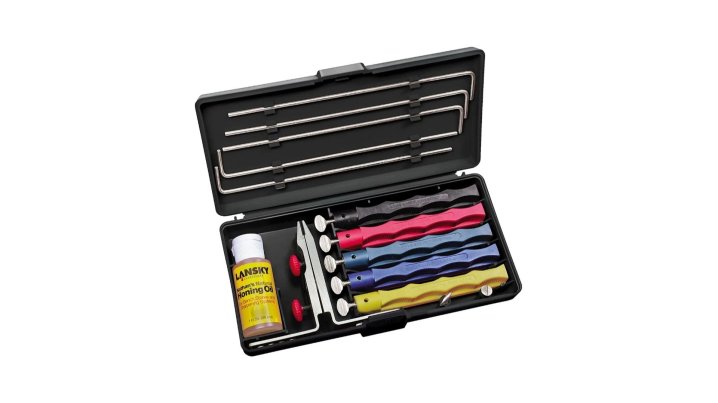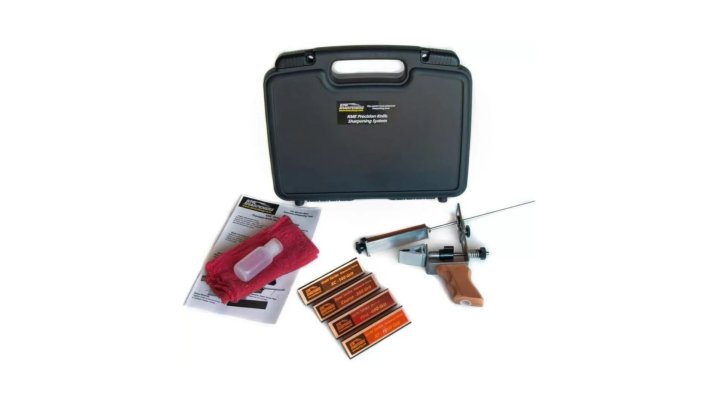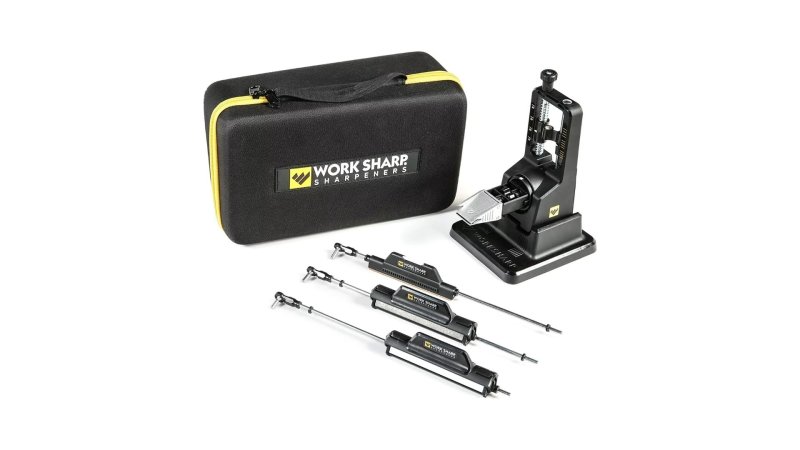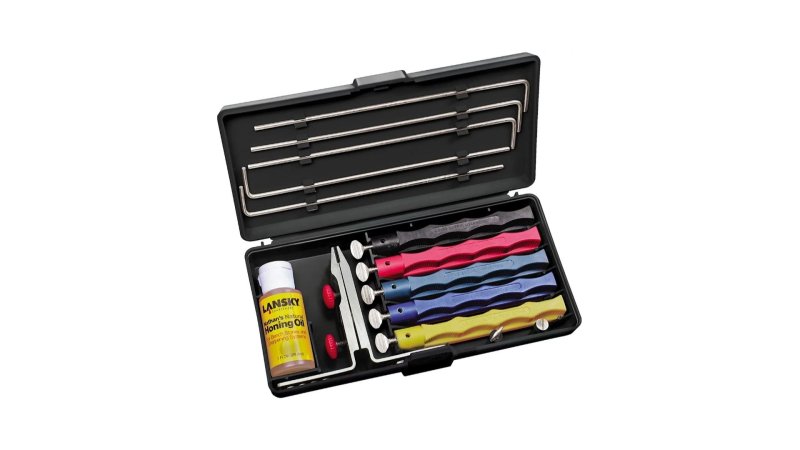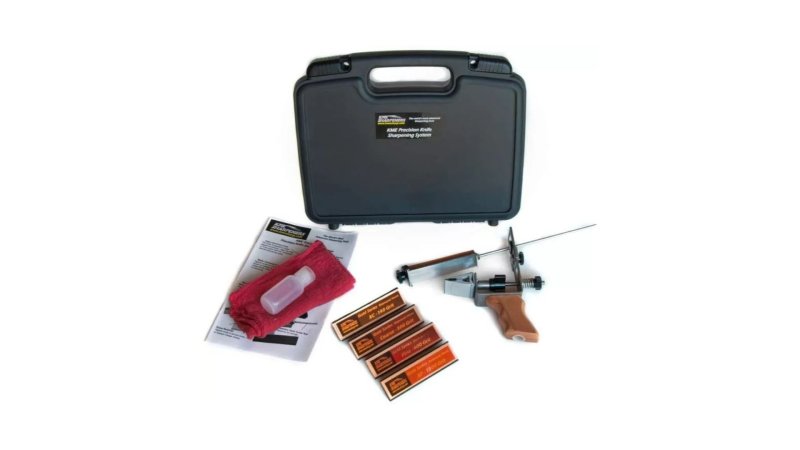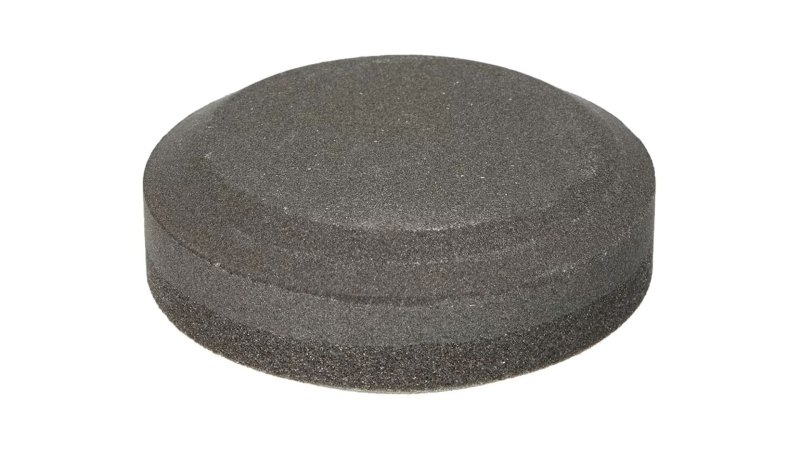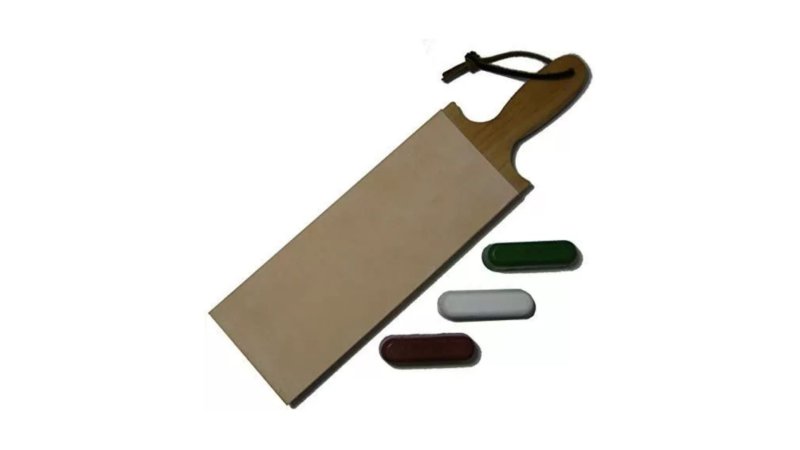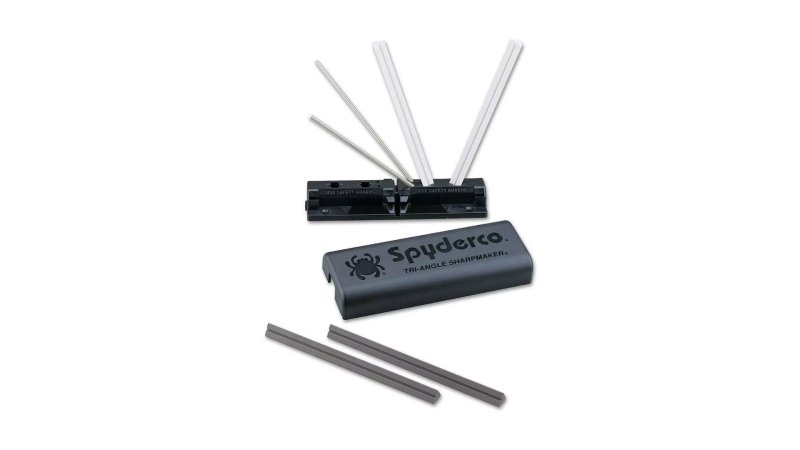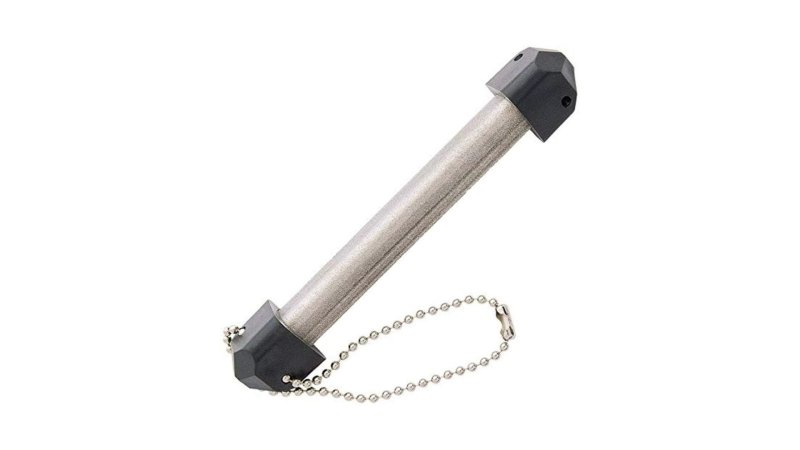We may earn revenue from the products available on this page and participate in affiliate programs.

There are few tools more versatile than a trusty knife. The best knives are sturdy, reliable, and, of course, sharp. Without a properly sharpened edge, your trusty knife is little more than a blunt force tool, which is why quality sharpening equipment is a necessity. Instead of getting a new blade every time your edge grows dull, investing just a few minutes in sharpening and upkeep can restore your knife to its former glory, or even a better edge than it had from the factory. After all, even Rambo couldn’t draw first blood without an acute edge.
Knife sharpeners have come a long way, and nowadays you can get your blade back to a precise hair-splitting edge faster than ever before. To help you cull through the innumerable available products, we’ve broken down everything you need to know about the best knife sharpeners on the market, so grab your gear and let’s get to it.
Methodology
I describe myself as a “knife nerd.” I’ve been collecting and selling knives for about a decade, and I was even a blacksmith apprentice. I’ve also written extensively about the subject for Task & Purpose. In addition to writing guides about Damascus knives, utility knives, and karambit knives, I’ve also reviewed knife products like the Cold Steel American Lawman, WE Stonefish, Leatherman Curl, Cold Steel Storm Cloud, QSP Penguin, and Spyderco Slip Stone. There isn’t another way to say it other than I’m a nerd about knives.
For this article, we used recommendations shared in forums around the internet, particularly a handful of Facebook groups for knife enthusiasts. We relied on these sources because the members tend to provide better feedback than what you’d find in product review sections on most knife websites.
The knife sharpener systems we selected came highly recommended because of their overall quality and performance. We looked for sharpeners that were durable, versatile, and easy to use. We also considered things like the materials used to make the product as well as the manufacturer’s reputation for quality control. We excluded any sharpener that wasn’t user-friendly or durable as well as all pull-through style sharpeners, which can do more harm than good to a blade.
We examined the traits that we mentioned through a combination of hands-on testing, handling, and crowdsourced information. We have extensive experience using Lansky systems, we handled the KME and Sharpmaker, and we relied on our trusted sources and experience to fill in any gaps.
For more information on our methodology and product reviews, check out the Task & Purpose review guidelines.
Best Overall
Work Sharp Precision Adjust Elite
Pros
- Made in USA
- Wide range of grits
- Easy to use
- Includes strop and carry case
- Doesn’t require lubricant
Cons
- Plastic frame
- Limited to smaller knives
Product Specs
Best Value
Lansky Deluxe Sharpening System
Pros
- Made in USA
- Upgrades available, including convex and diamond stones
- Includes storage case
- Metal construction
Cons
- Requires oil for alumina-oxide stones
- Limited edge angles
Product Specs
Editor’s Choice
KME Precision Sharpening System
Pros
- Made in USA
- More precise than less expensive systems
- Carrying case
Cons
- Price
Product Specs
Best for Axes
Lansky Puck (Dual Grit)
Pros
- Made in USA
- Dual-grit for easy reprofiling and touch ups
- Compact, ergonomic design
Cons
- No medium grit
Product Specs
Best Strop
Garos Goods Paddle Strop
Pros
- Made in USA
- Dual-sided
- Maple wood paddle
- Includes lanyard
Cons
- Might be too long for some users
Product Specs
Best for Field Maintenance
Spyderco Sharpmaker
Pros
- Made in USA
- Wide variety of add-on stones
- Compact, lightweight design
Cons
- ABS plastic base
- Doesn’t come with any coarse stones
Product Specs
Best for Serrations
Gatco TRI-SEPS Diamond Serration Sharpener
Pros
- Inexpensive
- Quick and simple to use
- Small enough to fit on a keychain
Cons
- Made in China
Product Specs
What to consider when buying knife sharpeners
Types of sharpeners
Fixed-angle systems
One of the more popular systems, a fixed-angle system involves immobilizing the blade in a vice and then running sharpening stones across the edge at preset angles. It is extremely easy to learn to use and is pretty difficult to mess up with. The main concern with them is that you have to be careful to not round off your tip by letting the stone overlap too much. These systems can struggle with knives that are too thin to clamp into the vice, and also with blades that feature extreme recurves.
Stones (freehand)
The oldest type of sharpener is free-handed stones, most colloquially known as whetstones. This was due to the majority requiring consistent lubrication with either water or oil. Nowadays, there are plenty of options that don’t require lubrication, so the term “whetstone” doesn’t really apply, but the concept remains the same. You have a slab of material, or “stone,” made out of a variety of materials. This can include ceramic, diamond, alumina-oxide, silicon-carbide, and novaculite stones, to name a few. Sharpening freehand is simple, conceptually. Just find the correct angle for the edge, and pull the blade back and forth across the stone, while holding that angle as consistently as possible. Naturally, this is much harder in practice, unless you, ya’know, practice. Because it’s freehand, it’s the hardest to become proficient at, but it’s by far the most versatile and satisfying.
Powered
This is arguably the fastest way to sharpen blades. It’s also indisputably the fastest way to ruin your blade, if you’re a beginner. Powered sharpeners can take many forms, but typically their advantage is their ability to quickly remove steel. It’s great if you’re experienced, and have to sharpen a lot of knives, but best avoided otherwise. One slip-up, and you just turned your cleaver into a kukri. A lot of the cheaper powered options leave a rather rough finish to the edge, but there are some quality options that are worth looking into, with our favorite powered model being the Tormek T8.
Pull-through sharpeners
If you’ve ever been in the sporting goods section, you’ve definitely seen at least one variant of these. Much like a sports car with 69 percent APR, it might be heavily promoted and look nice, but it’s always a bad idea. This type usually involves a polymer frame that you hold on a flat surface and pull the blade through to sharpen (hence the name). I’m not aware of a single variant of this that doesn’t damage your blade in some way, either by removing too much steel, or removing it unevenly, creating an unwanted recurve.
Pricing considerations for knife sharpeners
- Under $50: Compact and portable sharpeners fall in this price range, along with more basic handheld models. You can find some good equipment in this category, but there’s also some human refuse (like pull-through sharpeners) that is best avoided like E. coli.
- Over $50: Most quality sharpening systems and stones fall in this price range, largely due to their durability, design, effectiveness, and overall quality control. Buy once, cry once.
Tips and tricks
As with something you do for decades upon decades, you pick up a few tips and tricks along the way in terms of selecting the right product, and/or using it. That’s the case with us and sharpening equipment. To help you bridge the information gap, here’s a selection of what we’ve learned along the way.
- Let the stones do the work. You shouldn’t apply much more pressure than the weight of the stones or blade themselves. Applying too much force will only wear out your stones faster.
- Clean the blade before moving up on grit. Trying to refine your edge, or maybe put a polished finish on it? It’s not uncommon for some grit or slurry from the previous stone to remain on your blade. While this isn’t too noticeable with coarser grits, it becomes extremely obvious once you get around 1,000 grit, as you’ll all of a sudden have random scratches in what would have been a near-mirror finish.
- Take your time. The main thing easier than quickly sharpening a knife is quickly messing up the edge in your attempt to do so.
- Never let your stone overlap the tip of your blade more than a centimeter. Ok, maybe not exactly a centimeter, but the less your stone overlaps the tip of your blade, the less likely you are to round over your tip. The more edge you can keep in contact with the stone, the more it’ll help keep the tip pointy.
FAQs about knife sharpeners
You’ve got questions, Task and Purpose has answers.
Q: How do I know if my knife should be sharpened at 25 or 20 degrees?
A: It depends on your use, what steel the blade’s made from, and a few other things, but typically a 25-degree edge is close to the factory angles (new blades rarely have perfectly symmetrical edges from the factory), while remaining sturdy enough for extended utility use, without sacrificing too much sliciness. Have a knife in premium steel? A 20-degree edge might not be a bad idea. Bushcraft/survival knife? 25 to 30 degrees. Kitchen knife? 15 to 20 degrees. This is an art, as much as it is a science, so you’ll get the feel for it the more experience you get. I typically will attempt to get close to the factory angle by looking at how much of a gap there is between the apex of the edge and my stone; if I can see a small shadow there, I know to make the angle steeper, and vice versa. Just remember: Broad backs are strong, acute edges will a-cut. (Broader edges are stronger, while acute edges are more slicy.)
Q: Can a knife be too sharp?
A: Can a boat be too buoyant? A knife’s purpose is to be sharp, so no. There is no knife that’s too sharp, only users that are too careless. As odd as it may sound, sharp blades are safer than dull ones. Sharp knives cut smoother and more easily, while dull ones tend to catch or slip during use, leading to injury. Not only that, but whereas sharp knives leave a clean cut that is easily cleaned and heals smoothly, dull knives are more likely to rip and leave a jagged cut that’s significantly more difficult to clean, and tends to heal poorly with excessive scar tissue.
Q: Do knife sharpeners ruin knives?
A: It depends on what type of sharpener it is, and how you use it. The absolute worst kind of sharpener is a pull-through sharpener. These come in both powered and non-powered forms, but almost all of them result in removing more steel then needed, leaving a rough/jagged edge, and creating a recurve in the edge near the handle due to the nature of the system, reducing how much of the blade is actually usable. Powered grinders are next. While they aren’t inherently bad, any mistakes made happen much faster, and result in significantly more damage than on manual systems. Fixed-angle sharpening systems are better for novices, as it’s harder to irreparably mess up; the only caveats being that fixed-angle systems aren’t great at sharpening recurved blades, and if you overlap the tip of the knife too much with the stone, you can round it off, resulting in a notably less stabby tip.
